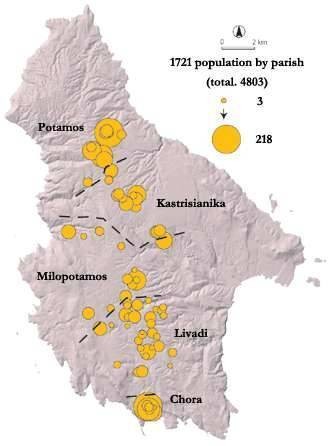Venetian Census, Tax and Notarial Records

Map of the 1721 Venetian population by parish, based on census data published under C. Maltezou's general editorship.
Principal Investigators:
John Bennet (Oxford)
Siriol Davies (Stirling)
Venetian influence in Kythera lasted from the early 13th to the end of the 18th century. During that period the island was administered in turn from Crete, the Peloponnese and Corfu, reflecting changes in the history of the Venetian overseas empire. These changes in orientation naturally affected the demographic history of the island and are evident, for example, in settlement names. Detailed records relating to the history of the island exist both in the Venetian state archives (Archivio di Stato di Venezia) and the local archives on the island (Historical Archive of Kythera). For example, published Venetian censuses from the latter archive, dating from the 18th century, provide a rich source of data for study of the population profile of the island at the time. By determining the location on the ground of the parish churches on which the censuses are based (mapped in a GIS environment by Andrew Bevan), it is possible to plot the density of population for the different districts of the island.

Venetian tax register from the Kytheran archives. Photography by John Bennet 2003.
Tax-registers in the local archives list tax-assessments for individuals and the location of their property, such as fields for grain, beans, olive-trees, fruit-trees etc. In this way it is possible to trace the property-holding of individuals and families and plot them spatially. For the purposes of this project the villages of Mitata, Fratsia and Strapodi have been selected as detailed case studies, not least because these three zones fall within the KIP archaeological survey area and therefore offer the chance to correlate historical information and land holding structure with the patterning of contemporary (late Venetian) material culture in the landscape. Extensive notarial archives also have the potential to reveal the nature of inheritance customs and the conditions of contracts for the exploitation of property. In Venice, administrative decisions and dispatches from the island can give a higher level overview of developments and problems in the governance of the island.
From:
Kythera Island Project website.
http://www.ucl.ac.uk/kip/ven.php